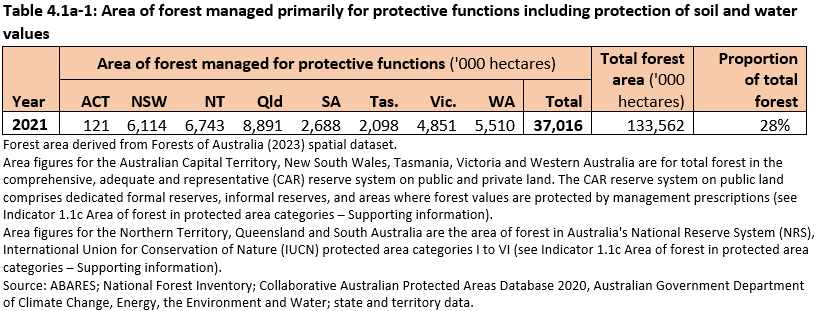The area of forest land where priority is given to protecting soil and hydrological functions provides an indication of the emphasis being placed by society on the conservation of these values. This indicator includes areas managed to protect soil and water by excluding incompatible activities.
This is the Key information for Indicator 4.1a, published October 2024.
- A total of 37.0 million hectares (28%) of Australia’s forest is managed for protection of soil and water values, most of which is native forest.
- The area of forest managed primarily for protection of soil and water values includes formal nature conservation reserves, informal reserves in multiple-use public native forests, forests protected by prescription and forested catchments managed specifically for water supply.
- There has been a slight increase in the area and proportion of forest managed for protection of soil and water values since the last report in 2018.
Forests are vital for soil conservation, preventing soil erosion, protecting water supplies and maintaining other ecosystem functions. Relevant state and territory regulations and guidelines that provide for sustainable forest management are designed to minimise soil erosion, protect soil physical properties, manage activities that could affect water yields and quality, and manage risks to water quality. State and territory based processes are also in place to monitor and ensure compliance with measures that protect forest soil and water resources.
A total of 37.0 million hectares of forest is managed for protection of soil and water values, and comprised largely of native forest with smaller areas of commercial plantations and other forest. This is 28% of Australia’s total forest area of 133.6 million hectares (Table 4.1a-1), and represents an increase in both the area and proportion reported in Australia’s State of the Forests Report 2018 (36.6 million hectares and 27%, respectively).
The area of forest managed primarily for protection of soil and water values includes formal nature conservation reserves, informal reserves in multiple-use public forests, forests protected by prescription (such as steep slopes, erodible soil types and riparian (streamside) zones where harvesting and road construction are not permitted), and forested catchments managed specifically for water supply.
Click here for a Microsoft Excel workbook of the data for Table 4.1a-1.
Subsequent updates to Indicator 4.1a will cover forests in catchments specifically to supply drinking water.

